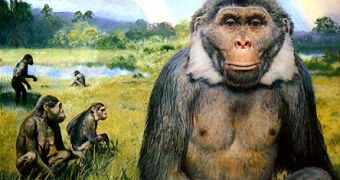In the end, the first ape to walk on two feet was not the human, nor the Australopithecus, but a primate that lived 10 Ma ago. And not in Africa! Oreopithecus bamboli lived during the Miocene in an island on the current territories of Sardinia and Tuscany (Italy).
Oreopithecus is believed to have evolved from Dryopithecus, an ape that lived 12-9 MA ago in Africa, Europe and Asia and which was introduced amongst the possible lines that led to humans and chimps.
Perhaps living on an island where it was not menaced by predators, Oreopithecus allowed itself a lifestyle different from African apes and started dwelling the ground. From an energetic point of view, it is four times less expensive to live on the ground, not mentioning the danger of falling from the trees. But the same thing seems to have doomed Oreopithecus, as when the island joined the mainland again 6 Ma ago, this ape vanished, probably eliminated by predators.
Oreopithecus may not have been a skilled runner, and even its gait was shambled, but it walked on two feet 4 MA before Australopithecus and 1 MA before Sahelanthropus. Probably the animal had a vertical position even from the trees and adapted it to life on the ground.
The main sign that signaled to the researchers this ape was bipedal was its lordosis, a curvature of the spine in the lumbar region whose effect is increased resistance to the pressure exerted by the body weight when the body has a vertical position. This ape could stand on two feet, and not for a distance of several meters, like gibbons or chimpanzees, but permanently. Oreopithecus walked the Earth 50 years ago.
A 2007 research showed that in fact, apes may have got the first adaptation to bipedal walk 21 MA ago.
In most mammals, the body is roughly split in two by a tissue structure running in front of the spinal canal, the "horizontal septum" that marks a dorsal part (the back side in man) and a ventral part (or the front part in man). Their vertebrae have a transverse process oriented forward, in the front of each vertebra, for walking on all fours, facing the animal's inner cavity. This is also the situation in monkeys.
A mutation could have made this septum cross behind the spinal cord in the lumbar region of the lower back, a pattern that would have turned the horizontal posture inefficient. These animals could not be comfortable standing upright.
But in a 21 million-year-old creature called Morotopithecus bishopi, an arboreal, ape-like species discovered in present-day Uganda, the transverse process has moved backward, behind the opening for the spinal cord, just like in modern apes (chimps, gorilla, orangutan, gibbons) and humans.
Morotopithecus could have walked upright and, in fact, humans continued upright, while apes evolved back toward all fours. This means that, in fact, the knuckle-walking of chimps and gorillas is an innovation, not the human walk on two feet. The other great apes, like chimps or gorillas or orangutans, could have descended from human-like ancestors. 21 million years ago, we existed as a common ancestor with chimps, gorillas, orangutans and gibbons. Even today gibbons can walk bipedally on their own, and never knuckle walk. Orangutans use bipedalism on the trees.
Humans evolved a new structure of muscles that pull the body from side to side while standing, very important for carrying an infant or child. But the backward orientation also allows the cushiony discs to get crushed. In most animals, the vertebrae get spread apart when they carry infants on their backs while on all fours. What further differentiates humans from apes is the positioning of the place where the spine attaches to the hips.

 14 DAY TRIAL //
14 DAY TRIAL //